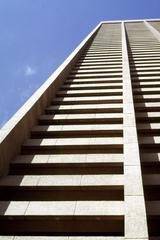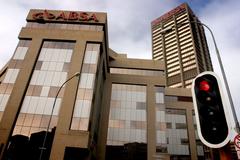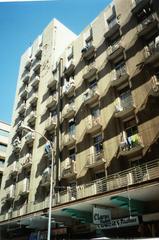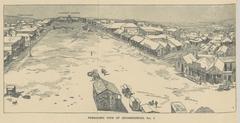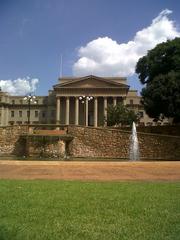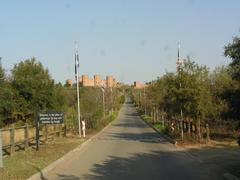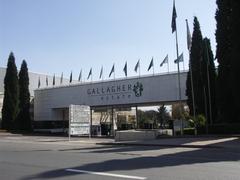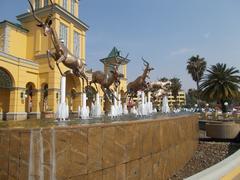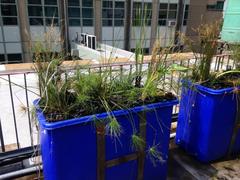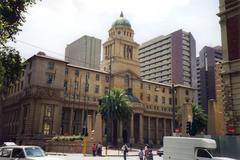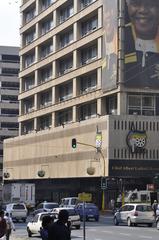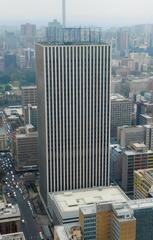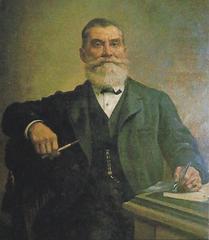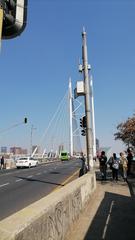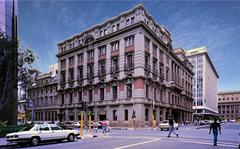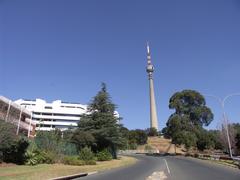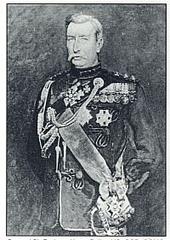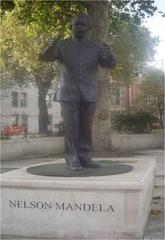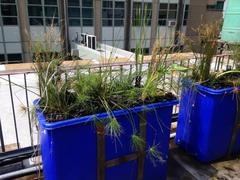
Carlton Centre Johannesburg: Visiting Hours, Tickets, and Historical Sites Guide
Date: 14/06/2025
Introduction
Rising above the heart of Johannesburg’s Central Business District, the Carlton Centre is a landmark of African ambition, architectural innovation, and urban transformation. Completed in 1973, this 223-meter skyscraper remains Africa’s tallest building, serving as both a symbol of Johannesburg’s dynamic spirit and a testament to its rich economic and cultural heritage. Once envisioned as a “city within a city,” the Centre combined luxury hospitality, retail, and commercial spaces—embodying the optimism of Johannesburg’s post-gold rush boom (aswica.co.za; carltoncentre.co.za).
Today, the complex draws visitors with its iconic “Top of Africa” observation deck, providing panoramic 360-degree views of Johannesburg and beyond. The Centre also plays a key role in Johannesburg’s urban renewal, hosting vibrant retail, business, and cultural events (southafrica.net; IOL News).
This guide offers detailed information on visiting hours, ticketing, accessibility, historical context, architectural highlights, and nearby Johannesburg historical sites—ensuring a rewarding visit for every traveler.
Table of Contents
- Introduction
- History and Conception
- Construction and Architectural Significance
- Visiting the Carlton Centre: Hours, Tickets, and Access
- Carlton Centre in Johannesburg’s Urban Evolution
- Renewal and Contemporary Role
- Nearby Historical Sites
- Architectural Features and Innovations
- Socio-Economic and Cultural Impact
- Visitor Tips and FAQs
- Conclusion
- References
History and Conception
The Carlton Centre’s development is rooted in Johannesburg’s explosive growth following the 1886 discovery of gold on the Witwatersrand (aswica.co.za). By the mid-20th century, the city demanded modern commercial infrastructure. Anglo American Properties, inspired by global urban trends, commissioned Skidmore, Owings & Merrill to design a mixed-use skyscraper that would become a beacon of economic prowess and urban sophistication (carltoncentre.co.za).
Construction and Architectural Significance
Construction began in 1967 and finished in 1973. The Carlton Centre’s 223-meter (732-foot), 50-story profile made it the tallest building in Africa—a distinction it still holds (southafrica.net). Its modernist design features clean lines, a reinforced concrete core, and abundant glass, maximizing both functionality and aesthetics.
Originally, the Centre included the prestigious Carlton Hotel, a sprawling shopping mall, and open-plan office spaces. The “Top of Africa” observation deck on the 50th floor offers unmatched city vistas (southafrica.net).
Visiting the Carlton Centre: Hours, Tickets, and Access
Observation Deck (“Top of Africa”)
- Location: 50th floor, access via mall elevators.
- Operating Hours:
- Monday–Friday: 9:00 AM – 6:00 PM
- Saturday: 9:00 AM – 5:00 PM
- Sunday: 9:00 AM – 2:00 PM
- Admission:
- Adults: R15
- Children under 10: R10
(Gauteng News)
- Tickets: Purchase at the entrance or online (carltoncentre.co.za).
- Accessibility: Elevators and ramps throughout; wheelchair-friendly facilities.
- Guided Tours: Offered periodically; check the official website for schedules.
Shopping Mall and Amenities
- Retail Hours: Most stores open 9:00 AM – 6:00 PM weekdays; shorter hours on weekends.
- Dining: Wide range of local and international cuisine.
- Banking: FNB branch on-site (FNB Carlton Centre).
- Essential Services: Pharmacies, clinics, and mobile providers available.
Getting There
- Address: 150 Commissioner Street, Marshalltown, Johannesburg
- Transport: Accessible by Rea Vaya buses, taxis, and the nearby Gautrain (Park Station).
- Parking: Secure, paid parking within the complex.
Carlton Centre in Johannesburg’s Urban Evolution
Upon opening, the Centre epitomized Johannesburg’s “City of Gold” status, hosting global dignitaries and anchoring the city’s commercial and social life (carltoncentre.co.za). However, from the late 20th century, the CBD faced urban decline, with businesses shifting to areas like Sandton (aswica.co.za).
Renewal and Contemporary Role
Post-apartheid, Johannesburg prioritized urban renewal. The Carlton Hotel closed in 1997, but the Centre’s offices and mall have persisted as key economic drivers. Revitalization projects like “The Fix” (Carlton Centre The Fix) aim to modernize infrastructure, attract new tenants, and reinvigorate the CBD’s appeal. The Centre now hosts over 180 retailers, entertainment venues, and community events, supporting jobs and local economic development.
Nearby Historical Sites
Enhance your visit by exploring these significant attractions:
- Gandhi Square: Landmark honoring Mahatma Gandhi’s legacy in South Africa.
- Johannesburg Art Gallery: Premier collection of local and international art.
- Apartheid Museum: In-depth museum chronicling South Africa’s struggle for freedom.
- Constitution Hill: Historic fort and Constitutional Court site.
- Maboneng Precinct: Trendy district with galleries, markets, and cafes (GPSmyCity).
Architectural Features and Innovations
The Carlton Centre’s design showcases modernist principles: a robust concrete core, expansive glass façades, and efficient vertical transport. The observation deck features interpretive displays, while the shopping mall was among South Africa’s first to blend retail, business, and hospitality in one integrated space (carltoncentre.co.za).
Socio-Economic and Cultural Impact
Economic Role
Since 1973, the Centre has been a commercial powerhouse—supporting retail, business, and tourism. Its revitalization is a linchpin for Johannesburg’s urban renewal, generating jobs and boosting local enterprise (Carlton Centre The Fix; IOL News).
Cultural Significance
The Carlton Centre is not just a structure but a civic hub. It’s a venue for cultural events, exhibitions, and community gatherings, reflecting Johannesburg’s diversity and resilience (southafrica.net). Preservation and public art initiatives support heritage and inclusivity.
Visitor Tips and FAQs
Tips for a Smooth Visit
- Best Time: Weekdays are quieter; arrive early for the observation deck.
- Safety: Remain vigilant in the CBD; use official transport and avoid displaying valuables.
- Dress: Wear comfortable shoes for exploring the extensive mall and deck.
- Photography: Bring a wide-angle lens for the best panoramic shots.
- Payments: Most outlets accept cards, but carry some cash for convenience.
FAQs
Q: What are the Carlton Centre’s visiting hours?
A: Observation deck: Monday–Friday 9:00 AM – 6:00 PM, Saturday 9:00 AM – 5:00 PM, Sunday 9:00 AM – 2:00 PM.
Q: How much is entry to the observation deck?
A: Adults R15, children under 10 R10 (Gauteng News).
Q: Is the Centre wheelchair accessible?
A: Yes, with elevators and ramps throughout.
Q: Are guided tours available?
A: Occasionally—check the official events page for schedules.
Q: What nearby attractions are recommended?
A: Constitution Hill, Apartheid Museum, Gandhi Square, Maboneng Precinct, and Johannesburg Art Gallery.
Conclusion
The Carlton Centre stands as a living monument to Johannesburg’s resilience, ambition, and urban transformation. Its mix of history, architecture, shopping, and culture offers a multifaceted visitor experience. For the best trip, check current visiting hours, book tickets in advance, and explore nearby historical sites. Stay updated via the Audiala app and the official Carlton Centre website for real-time news and exclusive events.
The Carlton Centre is more than a skyscraper: it’s a gateway to understanding Johannesburg’s storied past and vibrant future.
References
- ASWICA: Johannesburg History Timeline
- Carlton Centre Official Website
- SouthAfrica.net: Fantastic Views from Africa’s Highest Building
- IOL News: Inside Johannesburg’s Urban Crisis
- Carlton Centre The Fix Revitalization Initiative
- GPSmyCity: Carlton Centre
- Gauteng News: Carlton Centre
- FNB Carlton Centre
- Joburg.co.za: Carlton Centre
